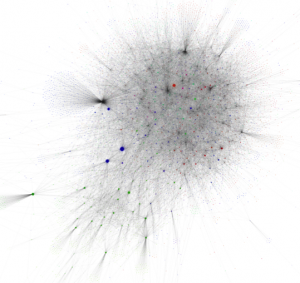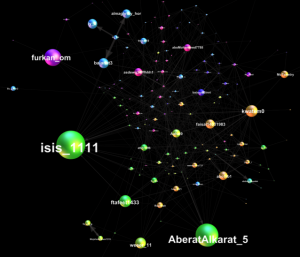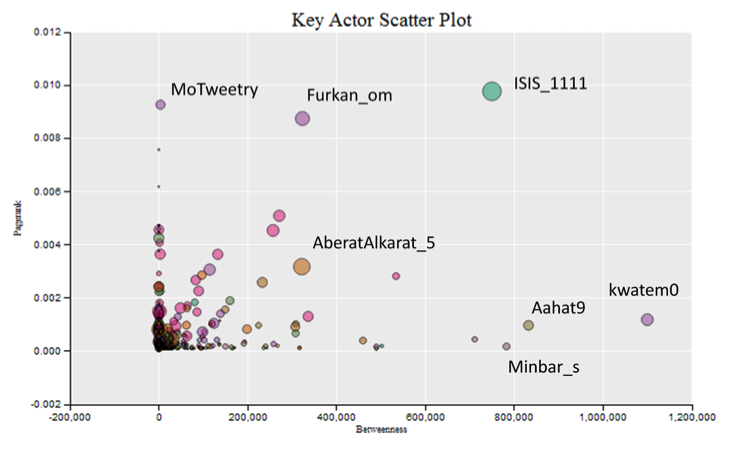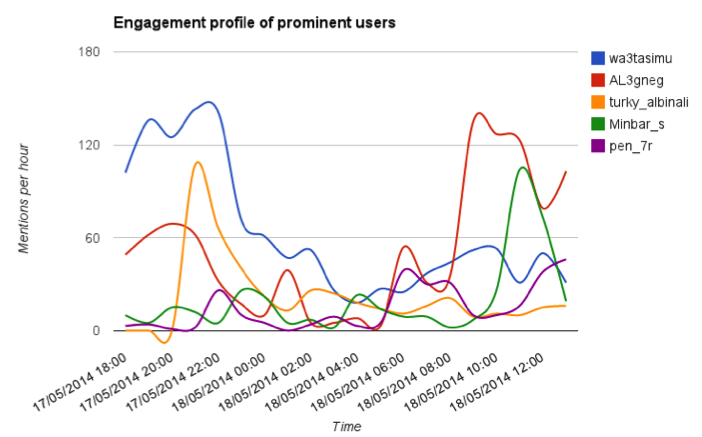As we outlined in a brief analysis in our first post, Ali Fisher and I will head into a more deeper analysis of our findings regarding the release of “The Clanging of the Swords, part 4”. In the next posting we will discuss and analyse the most important accounts that we will introduce in this part.
We do stress, however, that the reader should keep in mind that one of the key phenoma of jihadi Twitter activism in Syria is that most users engaged online are using mainly mobile platforms. This accounts for people inside Syria as much as outside – the preferred device to interact and Tweets are devices running Android followed by iPhone, as we had detailed in this graph in the last post. This shows that word of the video on YouTube, and archive.org was spread using a range of different digital technologies, but mainly mobile devices.
The video was also reflected upon on by sympathizers on tumblr, with users in one case posting a picture of the title of the video on a big flat screen while holding a Dutch labelled pop corn bag in front of the camera. This affirms the users claim to be “just one of your beloved brothers from The Netherlands.” Tumblr has become another social media outlet used by Jihadists in the past years. A pioneer short study on this phenomena – “Tumbling along the straight path” – was published by Rüdiger Lohlker, available here.
The effect of jihadi videos in the past years, due to their outreach and the popularity showcasing real men who act and stand up against frames of injustice is thus further highlighted – with the audience trying to actively particpate by the very least of expressing sympathy and spreading the word of the video by all of their means possible – and thus they consider themselves as a media-Mujahid. This is a role model not only sanctioned by senior jihadist ideologues, but also highly approved since the death of bin Laden.
Most Important Users
The information sharing about the video created a network of 6,428 Twitter users and 19,601 edges, some users were mentioned frequently. The graph below shows the frequency prominent users were mentioned.
To extend the analysis of prominent members of the network we created a representation of the network sharing the video via Twitter. It contains 6,428 Twitter users and 19,601 edges. The network had an average path length of 5.7 and a diameter of 15.
From the visual representation it is evident that there are a number of different users that were prominent in different sections of the network. Rather than the majority of the network orbiting one of a few influential accounts, in a series of hub and spoke structures, this network has multiple interconnected hubs through which information flows in multiple directions. This creates a level or redundancy providing the network with a degree of resilience that allows information to continue to flow in the event that some Twitter accounts may be suspended. This is because the interconnected hubs provide a level of redundancy so there are a number of other pathways through which information can flow. As Paul Baran’s calculations showed, distributed communications systems need a relatively low level of redundancy for the majority of the network to maintain communication in the event of major network disruption.
Viewing the network map in greater detail can show which users communicated with each other, which reached the same communities, and which were a bridge to specific communities. For example, in the network representation nodes of the same colour are within the same interconnected community. This means they are more likely to interact with other members of that community than the rest of the network. These can be assessed in greater detail in the online version where connections between specific nodes can be examined.
Through a refinement of the network image, to show only those users who have at least one mutual connection – meaning they have mentioned someone who has also mentioned them, a core group of users becomes visible.
This network of mutual connections contains 165 Twitter accounts (2.5% of the total network) including all of the top twenty five most mentioned users and on average a node in this core group has slightly more than five connections to other accounts in this group. This means the network has a density of 0.031 – meaning 3% of all possible connections exist. This is sufficient to provide the network with a level of resilience.
Resilience in this context is shown by impact on the network of losing important nodes, in the form of account suspensions.
With the loss of the five most connected nodes (ranked by times mentioned by others) every remaining node would still be connected to this network, with only a slight reduction in graph density to 0.027. Similarly, the removal of the five most important nodes (ranked by Pagerank) leaves the graph density unchanged at 0.031 and again, every remaining node would still be connected to the network. This means that the current occasional account suspensions are unlikely to have any practical impact on the ability of users to share information.
The identification of key actors in the network can provide greater insight into the way information travelled. For example, this can differentiate between those users that are important for reaching specific communities, from those users that are part of the core of the network. This analysis is important as not all users are influential in the same way. For example some will be influential within the core of the network while others are important as they form a bridge to wider communities.
Position on the scatter plot below is based on two network metrics pagerank and betweenness. Size is the number of times the account was retweeted or mentioned. Nodes with the same colour are in the same statistical community. If you are viewing the online version of this graph, mouse over dots to show each label, controls in the bottom left corner allow the user to zoom in on specific area of the chart.
When viewing the chart:
• Users in the bottom left of the graph tend to have no particular role and can be thought of as general users, although they may have high value to an often small and very specific group.
• Those in the top left of the graph tend to be in the core (or one of the cores) of the network. This indicates they are often those most invested in the network and have access to privileged information.
• Those in the bottom right of the graph fulfil the role of bridging between the core content producers and a specific community. The value of this role often comes from tailoring information to a specific ‘audience’ and as such these users are more valuable to that group but less important to everyone else.
• Users in the top right are rare. They have a dual function, as they have the same trusted status as those in the top left of the graph. They also fulfil the same ‘bridge’ role as users in the bottom right of the graph, reaching areas of the network which others do not.
In the case of the network disseminating information about the release Sas 4 the pagerank scores are particularly low which backs the earlier visual observation that the network is dispersed and has multiple interconnected hubs. The graph shows that @Minbar_s, @Aahat9, and @kwatem0 were important conduits for the spread of information to communities that other accounts could not reach. Conversely, @furkan_om and @MoTweetry were hubs which were a core part of the information sharing about this video. Most importantly, @ISIS_1111 was the single node that was able to fulfil both core and bridging functions simultaneously, with other accounts such as @AberatAlkarat_5 fulfilling a similar role to a lesser degree.
In addition to the roles users played in the network, the time at which they were influential is also an important aspect of the analysis. This is known as their engagement profile, the extent to which other twitter users engaged with them over a given time period.
Taking the top five most mentioned users in the network the engagement profiles shows that there were two periods of particularly intense activity. It also shows that different accounts were prominent at different times. For example, @wa3tasimu and @turky_albinali were prominent in the first peak but not the second, while @AL3gneg and @Minbar_S were prominent during the second peak.
This analysis demonstrates the need for counter-strategies to be agile as accounts become important at different times during the dissemination of content. In addition, it provides additional context to the key actor graph as @Minbar_s was an important conduit for information to a particular community, and the engagement profile shows that this role was likely to have been fulfilled later in period in which the video was being actively shared.
Interim Conclusions
· Jihadist groups have become increasingly sophisticated in their use of social media and mobile technologies.
· The release of 4 صليل الصوارم was announced through a resilient and dispersed network. This network has sufficient interconnection and redundancy to continue to operate indefinitely in spite of the current level of account suspensions.
o On each platform there are clusters of mutually reinforcing accounts which create a level of resilience that allows jihadists to have a persistent presence on the platform.
· The release of the 4 صليل الصوارم video highlights the multiplatform zeitgeist which has become a feature of the Jihadist social media phenomenon.
o Accounts on one social media platform are used to reinforce the content on other social media platforms, creating mutually reinforcing connections across platforms. This means users could turn to Facebook or Google+ if a specific Twitter account is suspended to locate the replacement Twitter account. In reality most jihadists that take the propagation element of their activity seriously have back-up accounts already set up with users following their primary account directed to also follow the back-up in case of an account suspension.
· The release of the video on a Saturday may have been a deliberate strategy to pick the day when those employed to challenge or disrupt the propagation of information about the video were least likely to be available.
This is a network based challenge – identifying groups rather than individual accounts.











One Response